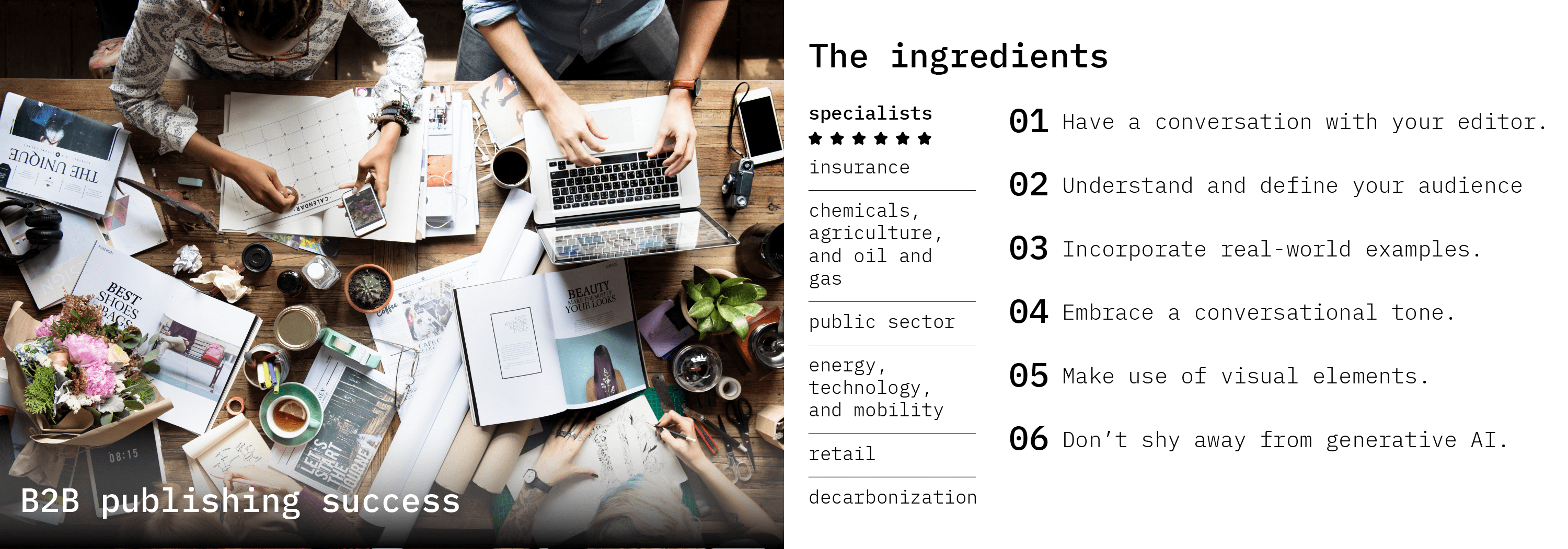This blog post is going to read like a cooking blog: a bunch of context, followed by a straightforward recipe.
I got into journalism for the writing and the opportunity to always be learning. I reported on consumer tech and got to try out an early solar-powered cellphone battery pack. (It was too slow to be a big hit.) I reported on the obstacles facing people of color in Chicago, such as higher rates of getting shot by police, unequal housing, and fresh-food shortages.
As a B2B ghostwriter, this dream has continued with new, business-focused topic areas. I love writing about policy that affects women, from the case for universal pre-K to discussion of the deeply entrenched medical coding practices based on male physiology but applied to women. After years of editing pieces across industries and functions, you become adept at tackling whatever comes your way.
Almost everything our clients publish today touches on sustainability, and that will continue as businesses sort out their perspectives and processes for reporting on their carbon footprints. The classic themes undergirding competitive strategy and effective collaboration will continue to be told, with new story arcs and real-world examples of successes and failures. (The lessons will be largely the same.)
When a project arrives better suited for a specialist, we give it to a specialist. Insurance has become a particular niche of mine within financial services. David covers chemicals, agriculture, and oil and gas. Annie’s beat is the public sector. Several folks on staff cover energy, technology, and mobility. A piece on retail in Southeast Asia? That’ll go to Lynn, who wrote an article on the topic last year. Airline decarbonization? Call KC.
These industry- and geography-specific takes give our clients (and, as learners, us) the opportunity to tell even the most classic business stories in new ways. They are, in many ways, our favorite things to work on because they tend to speak to a clear target audience and, as such, they need a sharp point of view and occasionally a bit of controversy.
You can still tell a big-picture, industry-agnostic story in a compelling way—but it requires more finesse. And while this subject-matter expertise provides our editors with critical context on a topic, the fact is that any one of us could pick up a piece on any topic and do a masterful job. That’s because we bring a handful of best practices to every article, report, charticle, or interview—no matter the industry or function.

So how do you make sure a publishing project is successful, regardless of your starting point?
- Have a conversation with your editor. Once you’ve submitted a first draft, an email introduction is fine. As soon as possible after that, we usually propose a kickoff call with an author team because we learn a lot more from listening to people talk than reading what’s on a page. There’s nuance to why the piece is being written, who the authors want to read it, and the conversations they’d like to have as a result. There are usually varying opinions on the team, and it’s helpful to know how to balance those proactively. (Do we really need to let these reviewers question the structure, or is that beyond reproach?) Every project is different, so a quality kickoff conversation with the decision-making authors is a sure way to set the project up for success.
- Understand and define your audience. The success of a publishing project lies not only in the clarity of your writing but also in your ability to connect with and engage your audience. Your editor is your advocate and guide for making that connection. Be as specific as possible when describing whom you’re trying to reach. “Leaders of procurement functions in pharma manufacturers” is much more specific than “the pharma industry.” This will allow you to tailor your messaging, tone, and examples to resonate with them on a personal level.
- Incorporate real-world examples. Readers often connect more with stories that feel authentic and relatable. When discussing competitive strategy, collaboration, or industry-specific topics, weave in real-world examples of both successes and failures. These examples add a practical dimension to your content, making it more engaging and memorable for your audience.
- Embrace a conversational tone. Even in the realm of B2B thought leadership, maintaining a conversational tone can make your content more accessible and enjoyable to read. Avoid overly technical jargon, and instead aim for clarity and simplicity. Imagine you’re explaining complex concepts to a friend, making the content approachable for a broader audience.
- Make use of visual elements. Enhance your content with visual elements such as charts, graphs, or relevant images. Visuals not only break up the text but also provide additional context and clarity. Whether you’re illustrating data trends or showcasing a company’s transformation journey, visual elements can convey information in a way that resonates with multiple types of learners.
- Don’t shy away from generative AI. With just a few words of careful prompting, ChatGPT can help turn a blank page into a jumping-off point. If you’re struggling to put a point into words, give ChatGPT a shot at it. Whatever you get, edit the response heavily to ensure accuracy and fit for your purpose. Generative AI is not a replacement for human thinking, but it can augment it. (And lest you think you can do away with your editor completely, our experiment demonstrates you can try, but the copy won’t read very well.)
As with any good recipe, these six core ingredients are meant to be a helpful foundation—but really successful pieces have something memorable and distinctive about them that can come only from the author’s brain. This intangible ingredient is the spark for attempting the recipe in the first place—and to complete the metaphor, an experienced editor is a trained chef who’s seen a lot of kitchens. Together, a successful editor–author team can create meaningful and memorable stories that stick with readers. That is, after all, why I got into journalism in the first place.




Leave a Reply
You must be logged in to post a comment.